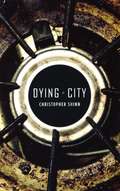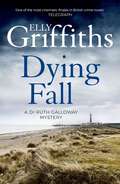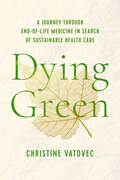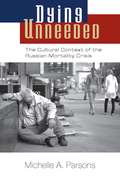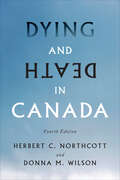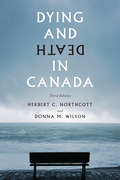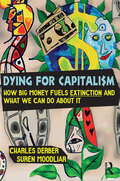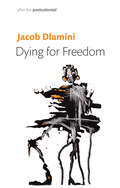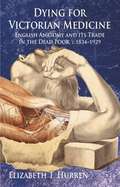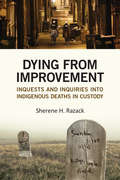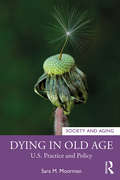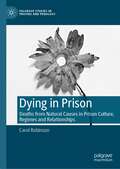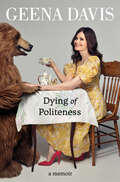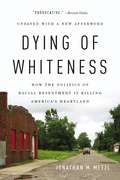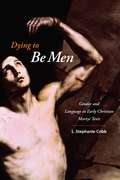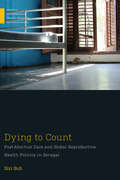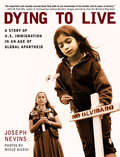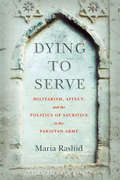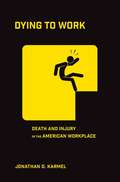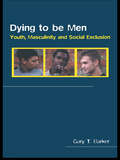- Table View
- List View
Dying City
by Christopher Shinn"The finest new American play I've seen in a long while . . . Dying City is a political play and also a psychodrama about what Arthur Miller called the politics of the soul. It's about public conscience and private grief, and real and symbolic catastrophes."--The New York Observer"Anyone who doubts that Mr. Shinn is among the most provocative and probing of American playwrights today need only experience the . . . sophisticated welding of form and content that is Dying City."--The New York TimesIn Christopher Shinn's new play Dying City, a young therapist, Kelly, whose husband Craig was killed while on military duty in Iraq, is confronted a year later by his identical twin Peter, who suspects that Craig's death was not accidental. Set in a spare downtown-Manhattan apartment after dark, scenes shift from the confrontation between Peter and Kelly, to Kelly's complicated farewell with her husband Craig. Shinn's creepy, sophisticated drama--infused with references to 9/11 and the war in Iraq--explores how contemporary politics and recent history have transformed the lives of these three characters.Christopher Shinn was born in Hartford, Connecticut, and lives in New York. His plays include Where Do We Live, Other People, What Didn't Happen, and On the Mountain, which have been widely produced in New York, across the United States, and in London. He is the recipient of an OBIE Award in Playwriting, as well as the Robert S. Chesney Award. He teaches playwriting at The New School for Drama.
Dying Fall: A spooky, gripping read from a bestselling author (Dr Ruth Galloway Mysteries 5) (The Dr Ruth Galloway Mysteries #5)
by Elly GriffithsWhen murder strikes close to home, Dr Ruth Galloway is determined to find justice - without ending up in the firing line herself.'One of the most cinematic finales in recent crime fiction' Daily TelegraphDr Ruth Galloway, forensic archaeologist, spends a lot of time looking at death. But now death has found her, with the news that her long-time friend and ex-colleague Dan Golding has been killed in a house fire.Ruth's grief soon turns to suspicion of arson when she receives a desperate letter from Dan, sent the day before he died. He had made a ground-breaking discovery that he was sure would change archaeology forever - and was petrified of the consequences. Ruth feels compelled to travel north to investigate further, alongside DCI Harry Nelson who is also drawn into the case. But where Ruth goes, so does her young daughter, Kate. This time, the risks are even higher.
Dying Green: A Journey through End-of-Life Medicine in Search of Sustainable Health Care (Critical Issues in Health and Medicine)
by Christine VatovecThe slow violence being inflicted on our environment—through everything from carbon emissions to plastic pollution—also represents an impending public health catastrophe. Yet standard health care practices are more concerned with short-term outcomes than long-term sustainability. Every resource used to deliver medical care, from IV tubes to antibiotics to electricity, has a significant environmental impact. This raises an urgent ethical dilemma: in striving to improve the health outcomes of individual patients, are we damaging human health on a global scale? In Dying Green, award-winning educator Christine Vatovec offers an engaging study that asks us to consider the broader environmental sustainability of health care. Through a comparative analysis of the care provided to terminally ill patients in a conventional cancer ward, a palliative care unit, and an acute-care hospice facility, she shows how decisions made at a patient’s bedside govern the environmental footprint of the healthcare industry. Likewise, Dying Green offers insights on the many opportunities that exist for reducing the ecological impacts of medical practices in general, while also enhancing care for the dying in particular. By envisioning a more sustainable approach to care, this book offers a way forward that is better for both patients and the planet.
Dying Inside: The HIV/AIDS Ward at Limestone Prison
by Benjamin Fleury-Steiner Carla Crowder"The HIV+ men incarcerated in Limestone Prison's Dorm 16 were put there to be forgotten. Not only do Benjamin Fleury-Steiner and Carla Crowder bring these men to life, Fleury-Steiner and Crowder also insist on placing these men in the middle of critical conversations about health policy, mass incarceration, and race. Dense with firsthand accounts,Dying Insideis a nimble, far-ranging and unblinking look at the cruelty inherent in our current penal policies. " ---Lisa Kung, Director, Southern Center for Human Rights "The looming prison health crisis, documented here at its extreme, is a shocking stain on American values and a clear opportunity to rethink our carceral approach to security. " ---Jonathan Simon, University of California, Berkeley "Dying Insideis a riveting account of a health crisis in a hidden prison facility. " ---Michael Musheno, San Francisco State University, and coauthor ofDeployed "This fresh and original study should prick all of our consciences about the horrific consequences of the massive carceral state the United States has built over the last three decades. " ---Marie Gottschalk, University of Pennsylvania, and author ofThe Prison and the Gallows "An important, bold, and humanitarian book. " ---Alison Liebling, University of Cambridge "Fleury-Steiner makes a compelling case that inmate health care in America's prisons and jails has reached the point of catastrophe. " ---Sharon Dolovich, University of California, Los Angeles "Fleury-Steiner's persuasive argument not only exposes the sins of commission and omission on prison cellblocks, but also does an excellent job of showing how these problems are the natural result of our nation's shortsighted and punitive criminal justice policy. " ---Allen Hornblum, Temple University, and author ofSentenced to Science Dying Inside brings the reader face-to-face with the nightmarish conditions inside Limestone Prison's Dorm 16---the segregated HIV ward. Here, patients chained to beds share their space with insects and vermin in the filthy, drafty rooms, and contagious diseases spread like wildfire through a population with untreated---or poorly managed at best---HIV. While Dorm 16 is a particularly horrific human rights tragedy, it is also a symptom of a disease afflicting the entire U. S. prison system. In recent decades, prison populations have exploded as Americans made mass incarceration the solution to crime, drugs, and other social problems even as privatization of prison services, especially health care, resulted in an overcrowded, underfunded system in which the most marginalized members of our society slowly wither from what the author calls "lethal abandonment. " This eye-opening account of one prison's failed health-care standards is a wake-up call, asking us to examine how we treat our forgotten citizens and compelling us to rethink the American prison system in this increasingly punitive age.
Dying Unneeded: The Cultural Context of the Russian Mortality Crisis
by Michelle A. ParsonsIn the early 1990s, Russia experienced one of the most extreme increases in mortality in modern history. Men's life expectancy dropped by six years; women's life expectancy dropped by three. Middle-aged men living in Moscow were particularly at risk of dying early deaths. While the early 1990s represent the apex of mortality, the crisis continues. Drawing on fieldwork in the capital city during 2006 and 2007, this account brings ethnography to bear on a topic that has until recently been the province of epidemiology and demography. Middle-aged Muscovites talk about being unneeded (ne nuzhny), or having little to give others. Considering this concept of "being unneeded" reveals how political economic transformation undermined the logic of social relations whereby individuals used their position within the Soviet state to give things to other people. Being unneeded is also gendered--while women are still needed by their families, men are often unneeded by state or family. Western literature on the mortality crisis focuses on a lack of social capital, often assuming that what individuals receive is most important, but being needed is more about what individuals give. Social connections--and their influence on health--are culturally specific. In Soviet times, needed people helped friends and acquaintances push against the limits of the state, crafting a sense of space and freedom. When the state collapsed, this sense of bounded freedom was compromised, and another freedom became deadly.This book is a recipient of the annual Norman L. and Roselea J. Goldberg Prize for the best project in the area of medicine.
Dying Unneeded: The Cultural Context of the Russian Mortality Crisis
by Michelle ParsonsIn the early 1990s, Russia experienced one of the most extreme increases in mortality in modern history. Men's life expectancy dropped by six years; women's life expectancy dropped by three. Middle-aged men living in Moscow were particularly at risk of dying early deaths. While the early 1990s represent the apex of mortality, the crisis continues. Drawing on fieldwork in the capital city during 2006 and 2007, this account brings ethnography to bear on a topic that has until recently been the province of epidemiology and demography. Middle-aged Muscovites talk about being unneeded (ne nuzhny), or having little to give others. Considering this concept of "being unneeded" reveals how political economic transformation undermined the logic of social relations whereby individuals used their position within the Soviet state to give things to other people. Being unneeded is also gendered--while women are still needed by their families, men are often unneeded by state or family. Western literature on the mortality crisis focuses on a lack of social capital, often assuming that what individuals receive is most important, but being needed is more about what individuals give. Social connections--and their influence on health--are culturally specific. In Soviet times, needed people helped friends and acquaintances push against the limits of the state, crafting a sense of space and freedom. When the state collapsed, this sense of bounded freedom was compromised, and another freedom became deadly. This book is a recipient of the annual Norman L. and Roselea J. Goldberg Prize for the best project in the area of medicine.
Dying and Death in Canada, Fourth Edition
by Donna Wilson Herbert NorthcottDying and Death in Canada provides a comprehensive, up-to-date examination of dying, death, and bereavement from a Canadian perspective. The fourth edition covers current issues and recent developments in the field, such as the implementation of Medical Assistance in Dying (MAID) and the implications of the COVID-19 pandemic. New topics include death doulas, death tourism, psychogenic death, bonds between the living and the dead, mass death events, and cultural diversity, sensitivity, and competence. This edition combines current research and language used to destigmatize conversations surrounding suicide, while new case studies offer personal accounts from doctors, nurses, and family members of the deceased. Exploring the significance of end-of-life experiences, Dying and Death in Canada shows that how we live influences how we die, and the society and culture in which we live has a profound effect on how we behave when confronted with dying and death.
Dying and Death in Canada, Third Edition
by Herbert C. Northcott Donna M. WilsonDying and Death in Canada offers a comprehensive, up-to-date examination of dying, death, and bereavement from a Canadian perspective. The third edition includes two new chapters that highlight trends and provide assessments of end-of-life care in Canada. Several new topics are covered, including assisted death, emerging trends in funerary practices and memorialization, and changing conceptualizations and interventions in the grieving process. The book also offers individual perspectives on dying and death from funeral directors, nurses, police officers, and others, told in their own words. An appendix lists recent and classic movies, television programs, documentary films, and other visual media sources dealing with dying and death.
Dying for Capitalism: How Big Money Fuels Extinction and What We Can Do About It (Universalizing Resistance)
by Charles Derber Suren MoodliarThis is an original, accessible book for scholars, students, activists, and the general public on the greatest crisis the world has faced. The authors challenge the widespread notion that a green and peaceful set of technological reforms in the current economic and political system – perhaps a “green capitalism” – can prevent disaster. Dying for Capitalism analyzes the “triangle of extinction” that links capitalism, environmental destruction, and militarism as a system that cannot sustain life on the planet. The authors analyze how the extinction triangle evolved historically, how it functions globally as integral to the world capitalist order, and how the United States has become the dominant “extinction nation.” They also show how recent anti-democratic and anti-scientific cultural and political forces intensify denial of the threat and subordinate health and survival to profit and extreme concentrated power. The book offers a “slender path” of social and political transformation that can prevent catastrophe. The path requires moving beyond current ruling systems. But possibilities of survival arise from action at local, state, regional, and global levels through multiple strategies and movements that already exist. The authors draw on the history of abolitionism and emancipation from slavery in the United States to show how a system that appears unchangeable can be transformed, while describing organizations, movements, and practices that are models of hope and a shift from the triangle of extinction to the “circle of creation.”
Dying for Daddy: The True Story of a Family's Worst Nightmare (St Martin's True Crime Library)
by Carlton SmithFrom the bestselling author of The Search for the Green River Killer: The account of the family tragedy that became one of California&’s most shocking murder cases. On a picturesque street in Sacramento County, California, three healthy saplings stand side by side. But what they symbolize are the deaths of three innocent people—two of them children. The man who took their lives, then planted trees in their honor, was their own husband and father. Hearts went out to Jack Barron when his wife, Irene, died mysteriously in her sleep. Soon after, his two young children were also found dead in their beds. Barron claimed they suffered from the same rare genetic disorder as their mother. But when his fifty-two-year-old mother died, also of asphyxiation in her sleep, law enforcement officials finally took action: The fatal pattern was impossible to ignore. Was this &“devoted&” father really a heartless murderer? Did he suffer from a bizarre syndrome known as Munchausen by proxy, whereby a parent kills a child to gain sympathy? With firsthand interviews and exclusive inside information, author Carlton Smith paints a chilling portrait of a man driven to commit the most unspeakable of acts.
Dying for Freedom: Political Martyrdom in South Africa (After the Postcolonial)
by Jacob DlaminiWhat happens when death becomes the ultimate marker of one’s commitment to one’s freedom? What happens when the opposite of freedom is not unfreedom but death, not slavery but mortality? How are we to think of the right to life when a political demand for dignity and honor might be more important than life itself?Dying for Freedom explores these questions by drawing on archival evidence from South Africa to show how death and conflicting notions of sacrifice dominated the struggle for political equality in that country. This political investment in death as a marker of commitment to the anti-apartheid struggle encouraged a masculinist style of politics in which the fight for freedom was seen and understood by many activists as a struggle literally for manhood. This investment generated a notion of political sacrifice so absolute that anything less than death was rendered suspect. More importantly, it resulted in a hierarchy of death whereby some deaths were more important than others, and where some deaths could be mourned and others not.This highly original account of the necropolitics of the liberation struggle will be of interest to students and scholars throughout the humanities and social sciences and to anyone interested in South Africa.
Dying for Victorian Medicine
by Elizabeth T. HurrenIn the nineteenth century the business of anatomy was very profitable. However, existing in a Victorian underworld, its shadowy details and potential links to the Jack-the-Ripper murders were seldom exposed. In this accessible and vibrant account, Elizabeth Hurren brings to life lost pauper stories recovered from the asylums, infirmaries, workhouses, body dealers, railway men and undertakers that supplied the medical profession with dissection subjects. The details of those trading networks, corpse sales, body parts fees, railway transportation costs and funeral expenses have never been documented before now, yet this economy of supply in the dead underpinned modern medicine. In Dying for Victorian Medicine, Hurren allows us to look for the first time into the human face of abject poverty, working back in the archives from death to touch the lives of those compelled by pauperism to give up a loved one's body for dissection.
Dying for the Truth
by Blog Del NarcoWhat is the value of telling the truth? For independent blog reporters in the midst of the Mexican Drug War, it's as important as their very lives, which are threatened on a daily basis.Blog del Narco is a heavily visited website, both in Mexico and the rest of North America, and it reveals the horrible savagery of the drug cartels. More than this, it also speaks of corruption and violence from the government itself.Many journalists in Mexico have been killed and silenced. Blog del Narco is not run by professional journalists, but it's the only forum for the true story of the violent drug war.Dying for the Truth is the first and only book release that contains both text and images, many of them gruesome, from this vital public forum.This book contains both the original Spanish-language posts in addition to their English translations. Truth is risky, and sometimes it's also harsh. Here is the reality of the Mexican Drug War, created in part by American demand for the products controlled by the cartels and their government collaborators.The Blog del Narco authors live anonymously and under threat in Mexico and aspire to relocate to the United States.
Dying from Improvement
by Sherene RazackNo matter where in Canada they occur, inquiries and inquests into untimely Indigenous deaths in state custody often tell the same story. Repeating details of fatty livers, mental illness, alcoholic belligerence, and a mysterious incapacity to cope with modern life, the legal proceedings declare that there are no villains here, only inevitable casualties of Indigenous life.But what about a sixty-seven-year-old man who dies in a hospital in police custody with a large, visible, purple boot print on his chest? Or a barely conscious, alcoholic older man, dropped off by police in a dark alley on a cold Vancouver night? Or Saskatoon's infamous and lethal starlight tours, whose victims were left on the outskirts of town in sub-zero temperatures? How do we account for the repeated failure to care evident in so many cases of Indigenous deaths in custody?In Dying from Improvement, Sherene H. Razack argues that, amidst systematic state violence against Indigenous people, inquiries and inquests serve to obscure the violence of ongoing settler colonialism under the guise of benevolent concern. They tell settler society that it is caring, compassionate, and engaged in improving the lives of Indigenous people - even as the incarceration rate of Indigenous men and women increases and the number of those who die in custody rises.Razack's powerful critique of the Canadian settler state and its legal system speaks to many of today's most pressing issues of social justice: the treatment of Indigenous people, the unparalleled authority of the police and the justice system, and their systematic inhumanity towards those whose lives they perceive as insignificant.
Dying in Old Age: U.S. Practice and Policy (Society and Aging Series)
by Sara M. MoormanThree-quarters of deaths in the U.S. today occur to people over the age of 65, following chronic illness. This new experience of "predictable death" has important consequences for the ways in which societies structure their health care systems, laws, and labor markets. Dying in Old Age: U.S. Practice and Policy applies a sociological lens to the end of life, exploring how macrosocial systems and social inequalities interact to affect individual experiences of death in the United States. Using data from the National Health and Aging Trends Study and Pew Research Center Survey of Aging and Longevity, this book argues that predictable death influences the entire life course and works to generate greater social disparities. The volume is divided into sections exploring demography, the circumstances of dying people, and public policy affecting dying people and their families. In exploring these interconnected factors, the author also proposes means of making "bad death" an avoidable event. As one of the first books to explore the social consequences of end of life practice, Dying in Old Age will be of great interest to graduate and advanced undergraduate students in sociology, social work, and public health, as well as scholars and policymakers in these areas.
Dying in Prison: Deaths from Natural Causes in Prison Culture, Regimes and Relationships (Palgrave Studies in Prisons and Penology)
by Carol RobinsonThis book uses empirical data gathered using ethnographic methods in two contrasting prisons to provide a rare insight into death and dying in prisons in the UK. The majority of deaths in prison custody in England and Wales result from natural causes, yet the experiences of people dying in prison and the impact of these deaths on the wider prison are under-researched areas. It provides a novel insight into the impact of deaths from natural causes on the prison as an institution and challenges existing work juxtaposing occupational philosophies of ‘care’ and ‘control’. It also identifies how end of life care is provided in prisons and the impact this has on culture and relationships shows how deaths from natural causes in prison custody ‘soften’ prison regimes, culture and relationships. It speaks to an international audience by drawing on the global literature including from the US.
Dying of Politeness: A Memoir
by Geena DavisFrom two-time Academy Award winner and screen icon Geena Davis, the surprising tale of her “journey to badassery”—from her epically polite childhood to roles that loaned her the strength to become a powerhouse in Hollywood.At three years old, Geena Davis announced she was going to be in movies. Now, with a slew of iconic roles and awards under her belt, she has surpassed her childhood dream—but the path to finding yourself never did run smoothly. In this simultaneously hilarious and candid memoir, Davis regales us with tales of a career playing everything from an amnesiac assassin to the parent of a rodent, her eccentric childhood, her relationships, and helping lead the way to gender parity in Hollywood—all while learning to be a little more badass, one role at a time. Dying of Politeness is a touching account of one woman’s journey to fight for herself, and ultimately fighting for women all around the globe.
Dying of Whiteness: How the Politics of Racial Resentment Is Killing America's Heartland
by Jonathan M. MetzlA physician's "provocative" (Boston Globe) and "timely" (Ibram X. Kendi, New York Times Book Review) account of how right-wing backlash policies have deadly consequences -- even for the white voters they promise to help. In election after election, conservative white Americans have embraced politicians who pledge to make their lives great again. But as physician Jonathan M. Metzl shows in Dying of Whiteness, the policies that result actually place white Americans at ever-greater risk of sickness and death. Interviewing a range of everyday Americans, Metzl examines how racial resentment has fueled progun laws in Missouri, resistance to the Affordable Care Act in Tennessee, and cuts to schools and social services in Kansas. He shows these policies' costs: increasing deaths by gun suicide, falling life expectancies, and rising dropout rates. Now updated with a new afterword, Dying of Whiteness demonstrates how much white America would benefit by emphasizing cooperation rather than chasing false promises of supremacy.Winner of the Robert F. Kennedy Book Award
Dying to Be Men: Gender and Language in Early Christian Martyr Texts
by Cobb L. StephanieAt once brave and athletic, virtuous and modest, female martyrs in the second and third centuries were depicted as self-possessed gladiators who at the same time exhibited the quintessentially "womanly" qualities of modesty, fertility, and beauty. L. Stephanie Cobb explores the double embodiment of "male" and "female" gender ideals in these figures, connecting them to Greco-Roman virtues and the construction of Christian group identities. Both male and female martyrs conducted their battles in the amphitheater, a masculine environment that enabled the divine combatants to showcase their strength, virility, and volition. These Christian martyr accounts also illustrated masculinity through the language of justice, resistance to persuasion, and-more subtly but most effectively-the juxtaposition of "unmanly" individuals (usually slaves, the old, or the young) with those at the height of male maturity and accomplishment (such as the governor or the proconsul). Imbuing female martyrs with the same strengths as their male counterparts served a vital function in Christian communities. Faced with the possibility of persecution, Christians sought to inspire both men and women to be braver than pagan and Jewish men. Yet within the community itself, traditional gender roles had to be maintained, and despite the call to be manly, Christian women were expected to remain womanly in relation to the men of their faith. Complicating our understanding of the social freedoms enjoyed by early Christian women, Cobb's investigation reveals the dual function of gendered language in martyr texts and its importance in laying claim to social power.
Dying to Be Men: Gender and Language in Early Christian Martyr Texts (Gender, Theory, and Religion)
by L. Stephanie CobbAt once brave and athletic, virtuous and modest, female martyrs in the second and third centuries were depicted as self-possessed gladiators who at the same time exhibited the quintessentially "womanly" qualities of modesty, fertility, and beauty. L. Stephanie Cobb explores the double embodiment of "male" and "female" gender ideals in these figures, connecting them to Greco-Roman virtues and the construction of Christian group identities. Both male and female martyrs conducted their battles in the amphitheater, a masculine environment that enabled the divine combatants to showcase their strength, virility, and volition. These Christian martyr accounts also illustrated masculinity through the language of justice, resistance to persuasion, and-more subtly but most effectively-the juxtaposition of "unmanly" individuals (usually slaves, the old, or the young) with those at the height of male maturity and accomplishment (such as the governor or the proconsul). Imbuing female martyrs with the same strengths as their male counterparts served a vital function in Christian communities. Faced with the possibility of persecution, Christians sought to inspire both men and women to be braver than pagan and Jewish men. Yet within the community itself, traditional gender roles had to be maintained, and despite the call to be manly, Christian women were expected to remain womanly in relation to the men of their faith. Complicating our understanding of the social freedoms enjoyed by early Christian women, Cobb's investigation reveals the dual function of gendered language in martyr texts and its importance in laying claim to social power.
Dying to Count: Post-Abortion Care and Global Reproductive Health Politics in Senegal (Medical Anthropology)
by Siri SuhDuring the early 1990s, global health experts developed a new model of emergency obstetric care: post-abortion care or PAC. In developing countries with restrictive abortion laws and where NGOs relied on US family planning aid, PAC offered an apolitical approach to addressing the consequences of unsafe abortion. In Dying to Count, Siri Suh traces how national and global population politics collide in Senegal as health workers, health officials, and NGO workers strive to demonstrate PAC’s effectiveness in the absence of rigorous statistical evidence that the intervention reduces maternal mortality. Suh argues that pragmatically assembled PAC data convey commitments to maternal mortality reduction goals while obscuring the frequency of unsafe abortion and the inadequate care women with complications are likely to receive if they manage to reach a hospital. At a moment when African women face the highest risk worldwide of death from complications related to pregnancy, birth, or abortion, Suh’s ethnography of PAC in Senegal makes a critical contribution to studies of global health, population and development, African studies, and reproductive justice.
Dying to Live
by Mizue Aizeki Joseph NevinsPraise for A Not-So-Distant Horror:"[A] remarkable book."--Noam ChomskyTold through the life story of a young man who perished in the California desert, Dying to Live is a compelling account of US immigration/border enforcement and the rapidly growing death toll among migrants. Stunning photos by Mizue Aizeki complement the text.Joseph Nevins authored Operation Gatekeeper: The Rise of the Illegal Alien and the Making of the U.S.-Mexico Boundary (Routledge, 2002), and A Not-So-Distant Horror (Cornell, 2005). His writings have appeared in the Boston Review, The Christian Science Monitor, and the International Herald Tribune.
Dying to Serve: Militarism, Affect, and the Politics of Sacrifice in the Pakistan Army (South Asia in Motion)
by Maria RashidThe Pakistan Army is a uniquely powerful and influential institution, with vast landholdings and resources. It has deep roots in the colonial armed forces and relies heavily on certain regions to supply its soldiers, especially parts of rural Punjab, where men have served in the army for generations. These men, their wives and mothers, and the military culture surrounding them are the focus of Maria Rashid's Dying to Serve, which innovatively and sensitively addresses the question: how does the military thrive when so much of its work results in injury, debility, and death? Taking ritual commemorations of fallen soldiers as one critical site of study, Rashid argues that these "spectacles of mourning" are careful manipulations of affect, gendered and structured by the military to reinforce its omnipotence in the lives of its subjects. Grounding her study in the famed martial district of Chakwal, Rashid finds affect similarly deployed in recruitment and training practices, as well as management of death and compensation to families. She contends that understanding these affective technologies is crucial to challenging the appeal of the military institution globally.
Dying to Work: Death and Injury in the American Workplace
by Jonathan D. KarmelIn Dying to Work, Jonathan Karmel raises our awareness of unsafe working conditions with accounts of workers who were needlessly injured or killed on the job. Based on heart-wrenching interviews Karmel conducted with injured workers and surviving family members across the country, the stories in this book are introduced in a way that helps place them in a historical and political context and represent a wide survey of the American workplace, including, among others, warehouse workers, grocery store clerks, hotel housekeepers, and river dredgers.Karmel’s examples are portraits of the lives and dreams cut short and reports of the workplace incidents that tragically changed the lives of everyone around them. Dying to Work includes incidents from industries and jobs that we do not commonly associate with injuries and fatalities and highlights the risks faced by workers who are hidden in plain view all around us. While exposing the failure of safety laws that leave millions of workers without compensation and employers without any meaningful incentive to protect their workers, Karmel offers the reader some hope in the form of policy suggestions that may make American workers safer and employers more accountable. This is a book for anyone interested in issues of worker health and safety, and it will also serve as the cornerstone for courses in public policy, community health, labor studies, business ethics, regulation and safety, and occupational and environmental health policy.
Dying to be Men: Youth, Masculinity and Social Exclusion (Sexuality, Culture and Health)
by Gary BarkerOne of the first comparative reflections of its kind, this book examines the challenges that young men face when trying to grow up in societies where violence is the norm. Barker, who has worked directly with low-income youth and witnessed first hand the violence he describes, provides a compelling account of the young men's struggles. He discusses the problems these men face in other areas of their lives, including the difficulty of staying in school, the multiple challenges of coming of age as men in the face of social exclusion, including finding meaningful employment, and their interactions with young women, including sexual behaviour and the implications of this for HIV/AIDS prevention. The book presents examples of evaluated programs that have been able to aid young men in rethinking what it means to be a man and ultimately focuses on 'voices of resistance' – young men who find ways to stay out of violence and to show respect and equality in their relationships, even in settings where male violence and rigid attitudes about manhood are prevalent.
